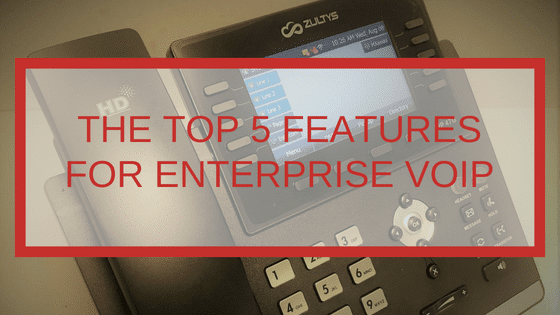Voice over IP (VoIP) is undoubtedly the way to streamline your business’s communication systems and save at the same time. But not all VoIP systems are created equal. Certain products are much more suited to small businesses than large companies with hundreds of users, each with several different lines to their name. Fold in instant messaging, email and conferencing, and your business’s communication network gets even more complicated.
You need a system with features built to handle that kind of heavy usage while easing the administrative burden on your employees. Ideally, your VoIP phone system should also allow you to centralize communication channels and make it simpler to configure mobile users and settings. More specifically, your enterprise VoIP should have the following top five features.
User Templates for Easy Programming
Managing enterprise level communication systems takes a lot of administration, particularly if your existing phone service has no way to program user templates and settings. Users naturally fluctuate more frequently in a large business as new employees are hired or promoted every day. And user privileges on large VoIP systems can get complex. Certain employees require high-level permissions, such as the ability to dial internationally or temporarily change their location. Managers may need to run call reports, to listen in on calls or see team members’ statuses.
Manually assigning privileges one at a time is time consuming and inefficient. Ideally, your VoIP phone system should allow admins to create user templates, facilitating quick user creation and avoiding potential errors that can be introduced through manual programming. One benefit to VoIP is that typically, these kind of adjustments can be made using accompanying software installed on the admin’s computer. In turn, this can shave hours off routine administration.
Integration with Unified Communications
The bulk of today’s communication occurs over multiple channels: a typical employee might use text, email, voicemail, video chat and their mobile phone all in one day. Switching back and forth between multiple applications to manage all these communication channels can be cumbersome and confusing — particularly if you’re looking to integrate mobile devices into your workflow.
Unified communications (UC) platforms simplify this process by folding all communication systems into one product. All voicemail messages are converted to text, making them completely searchable through your UC application, along with your email and instant messages. Your mobile and desk phones can be connected so that they direct to the same inbox. Your address book with all your contacts is managed right from one platform, meaning you can can launch a video conference directly from a instant message or voicemail.
Choosing a VoIP phone system that is compatible with UC applications opens up a world of communications efficiency features for employees of enterprise organizations. It’s definitely something to look for when shopping for a VoIP service.
Mobile and Remote Compatibility
Speaking of mobile phones, mobile — and by extension, remote — compatibility is a major plus for a VoIP phone system. Large businesses typically have multiple locations, with workers in many different time zones and some working off-site.
Enterprise VoIP should be mobile ready so that employees can take calls from their smartphone or make online calls from their laptop when working remotely. This means that your VoIP system routes multiple phone lines to one extension, allowing users to set their location and time zone. Many VoIP services come with a companion mobile UC application so that all communication channels can be accessed away from the desk.
A Dedicated VoIP Circuit
Bandwidth alone can’t solve all call quality issues. Jitter, latency and packet loss can still cause interruptions and dropped calls if you share VoIP with your public internet. And for many enterprise level businesses, call quality of service is non-negotiable.
Hosted voice over a dedicated circuit is the way to avoid these issues and improve VoIP quality. With a dedicated circuit, your VoIP phone system is connected directly to your provider’s data centers. Using a technology known as multiprotocol label switching (MPLS), providers can manage packet loss, jitter, latency and other issues that can sink VoIP call quality. The result is landline-quality calling with all the features of VoIP.
Auto-Attendant
An auto-attendant, otherwise known as a digital receptionist, is a huge win for enterprise efficiency. This feature allows incoming calls to be directed to a menu of various office departments, rather than relying on a receptionist to answer the call.
Auto-attendant also ensures that calls are answered even when team members are unavailable. It improves efficiency by replacing human operators, affording major cost savings for large businesses with several offices.
These features are ideal for most large companies, but every business is different. Other factors — such as optional Salesforce and other third-party integrations, backup and storage, and presence — may ultimately drive your decision to go with one provider over another.
It’s worth carefully weighing your options and business needs before you commit. If you’re looking for advice in that process, our consultants can help. We can analyze your use case and find the right VoIP phone system for you. Contact us today for more information, and start simplifying your company’s communication.

